
|   |

|   |
 e-mail: ukb7@rediffmail.com Stylization par excellence Photos: Amarendra Nath Dutta April 10, 2022 The traditional Sanskrit literature has been replete with couplets and quadruplets holding forth on moralistic aphorisms. Full of similes and metaphors, they seek to provide delightful ethical judgments and guidance on appropriate conduct of life and society. A familiar couplet, holding forth on consequences of excessive pride, begins with: Ati darpe hata Lanka..., and ends with the moral stricture: Sarvam atyatam garhitam. 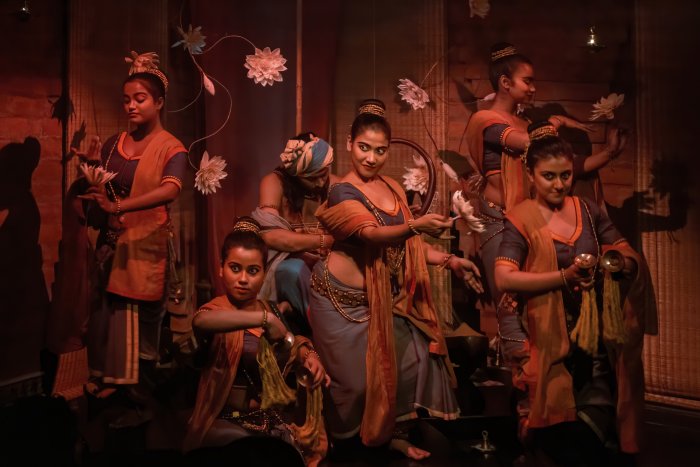 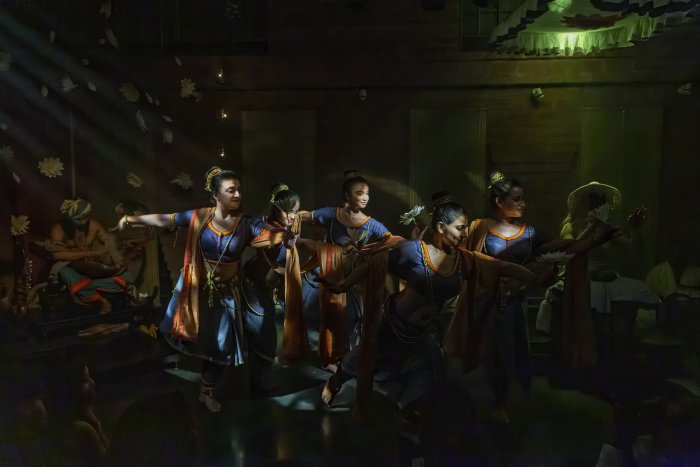 The Keralan poet-playwright Visvanatha used the legend of Kalyana Saugandhikam from the epic Mahabharata's Vanavasa Parva where the Pandavas were in exile in the Kamyaka forest and Arjuna was away from the rest of the Pandavas. In the story, Draupadi happens to see a Saugandhika blossom (an auspicious and fragrant water lily) carried by the breeze. Holding it in her palm, she requests her affectionate husband Bhima for more of them. Without hesitation, Bhima agrees to fulfil his beloved's wish and begins his journey through the thick woods for the flower. Known for his strength, Bhima destroys every obstacle in his way and reaches Kadali forest. At that time, Hanumana was doing his meditation in that forest and his prayers are intercepted by the sound of Bhima destroying the trees on his way. Hanumana realises that it is Bhima, his own younger brother (both Hanumana and Bhima being sons of Vayu, the God of wind). He decides to teach his loving but arrogant brother a lesson, and takes the form of an old monkey, lying on the path. Soon Bhima reaches there and gets agitated on seeing the old monkey carelessly obstructing his way. First, he asks the monkey to move out, but Hanumana pleads his inability. Bhima tries to lift the monkey's tail with his mace to get past him but, to his surprise, he cannot lift the tail and his mace gets trapped under the tail! Bhima realises that it is no ordinary monkey and enquires about it, when the monkey reveals his original form as none other than his own elder brother. Bhima feels sorry for his behaviour and seeks his brother's forgiveness. Hanumana shows his true form to Bhima on Bhima's wish, blesses him and gives instructions on how to find the Saugandhika flower. Having learnt the intended lesson, Bhima continues his journey to fetch the bloom. 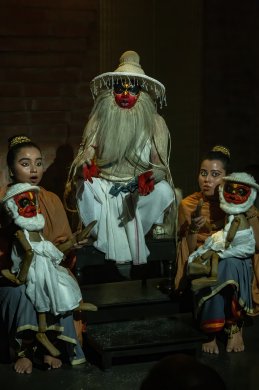 Rasa-Bala-Buddhi, presented on March 20, as part of their Natyadharmi Utsav 2022, by Chidakasha Kalalaya, was an adaptation of Saugandhika Haranam (a favourite of Koodiyattam and Kathakali). It was the maiden dramatic direction by Kalalaya's principal student Sayak Mitra working on Natya Shastra. Additionally, Sayak's Shivadashani Scholarship under Inlac in 2021 enabled him to train in two different surviving ancient theatre art forms: Ankiya Nat of Assam and Chakyar Koothu of Kerala. In both, his focus was on Sutradhaari (storytelling). Sayak dazzled with his all-round concept and visualization by developing the one-act play as a fully blown dance drama performed in several zones of the theatre space, with a narrative style for telling a tale within a tale. As a curtain raiser, Hanumana is seen in an elevated zone as an old, decrepit monkey reminiscing on his past to two glove puppets (coloured in the style of pacha characters), who enthusiastically respond and keep playing gleefully with his long dangling tail. In another zone, the Pandava queen witnesses the Saugandhika blossoms being caressed by her dancing companions in the windswept space and seemingly floating by. Soon from the back, Bhima leaps forward into yet a third zone, gallivanting about his mighty mace and physical prowess, showing an instance or two! The old monkey laboriously carries his unwilling body forward and lies now in yet another space, obstructing Bhima's further progress and still muttering his soliloquy. By this time, the Queen's companions have transformed themselves into denizens of the forest reacting to the ever-vaunting Bhima with their giggles. Bhima's encounter with the "pretend" monkey makes for hilarious drama, with light and shade playing on his face according to the alternating moods of his self-condemnation and recollecting his mighty power, interjected by Hanumana's apparent incapacity to move away even an inch! Eventually, Bhima's recapitulation follows, Hanumana relents and - bathed by celestial streaming white light from the top - raises himself to reveal his full form and demonstrates, at his brother's request, an ethereal dance. The Marga dancers' teamwork, as taught by their guru Piyal Bhattacharya, is superb with excellent support in lighting and sound. The overall impact is mesmerising. 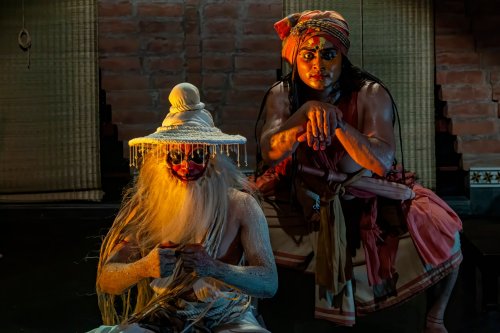 Extracts from interview with the director: 1. What is the significance of your title? My story is based on 'Vayu'. Bhima is 'Vayu Putra' who is suggestive of Bala (power). Hanumana is another 'Pavana Putra' who is suggestive of Buddhi (intelligence). The Saugandhika flower that has floated by air and dropped in front of Panchali, is Rasa (flavour). The whole story is really about the flow of wind with fragrance and romance, which provoked Bhima to reach Amaravati to collect the flower for his beloved. But the venture is full of danger and trouble. He met Hanumana in disguise on the way, who saved his life and suggested the way to reach the place and how to convince the Yaksha-Raksha-Gandharvas to serve his purpose. 2. What is the primal significance of Vayu (the wind)? The Indian worldview is that without Vayu no movement or activity is possible. In the physical plane of the earth, the corporeal Vayu is the driving force of any motion or activity. The physical structure of the human plane, according to Ayurveda, comprises five types of Vayu: Prana, Apana, Vyana, Udana and Samana, which can be regulated by the practice of Yoga. Hanumana, a mythical character, has mastered the state of contemplation by dominating all the five physical Vayus. 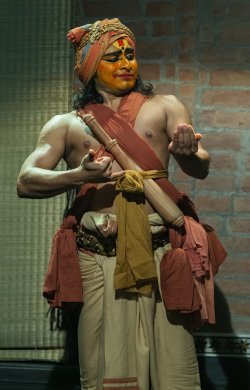 3. There is a lot of storytelling within the play... Hanumana belongs to the Satya era and Bhima to Dwapara: two different time and space that we can observe on the stage. I have interpreted Hanumana as Sutradhara, a storyteller, telling the story to the monkeys. I used two monkey puppets to create the ambience of Gandhamadana Mountain. The puppet face makeup is a glorious re-imagining of Koodiyattam's Hanumana, created by Sudip Gupta, the SNA awardee puppeteer. 4. And the dramatis personae are... My play's Gandharva Loka is full of several Natis (female dancers) and one Gandharva (Subhendu Ghosh). Natis are Pinki Mondal, Shreetama Chowdhury, Amrita Dutta, Smita Majumder and Sayani Bagchi. Hanumana is performed by Madan Mohan Kumar and Bhiman by Rudra Prasad Roy. Light is designed by Soumen Chakraborty, photo and videography by Amarendra Nath Dutta. The spectacular set and props are by Madan Mohan Kumar, Pinki Mondal and Subhendu Ghosh. The whole performance is presented under the guidance of our guru Piyal Bhattacharya. 5. Finally, how do you classify your play according to the Natya Shastra? It should be put under Preksanaka category, i.e., a one-act play with mainly male characters. As far as Dasha Rupaka group is concerned, it is a Vyayoga category emphasizing martial arts, since Bhima is showing off his physical prowess all the time to destroy the surrounding obstacles!  Dr. Utpal K Banerjee is a scholar-commentator on performing arts over last four decades. He has authored 23 books on Indian art and culture, and 10 on Tagore studies. He served IGNCA as National Project Director, was a Tagore Research Scholar and is recipient of Padma Shri. Post your comments Pl provide your name and email id along with your comment. All appropriate comments posted with name and email id in the blog will also be featured in the site. |